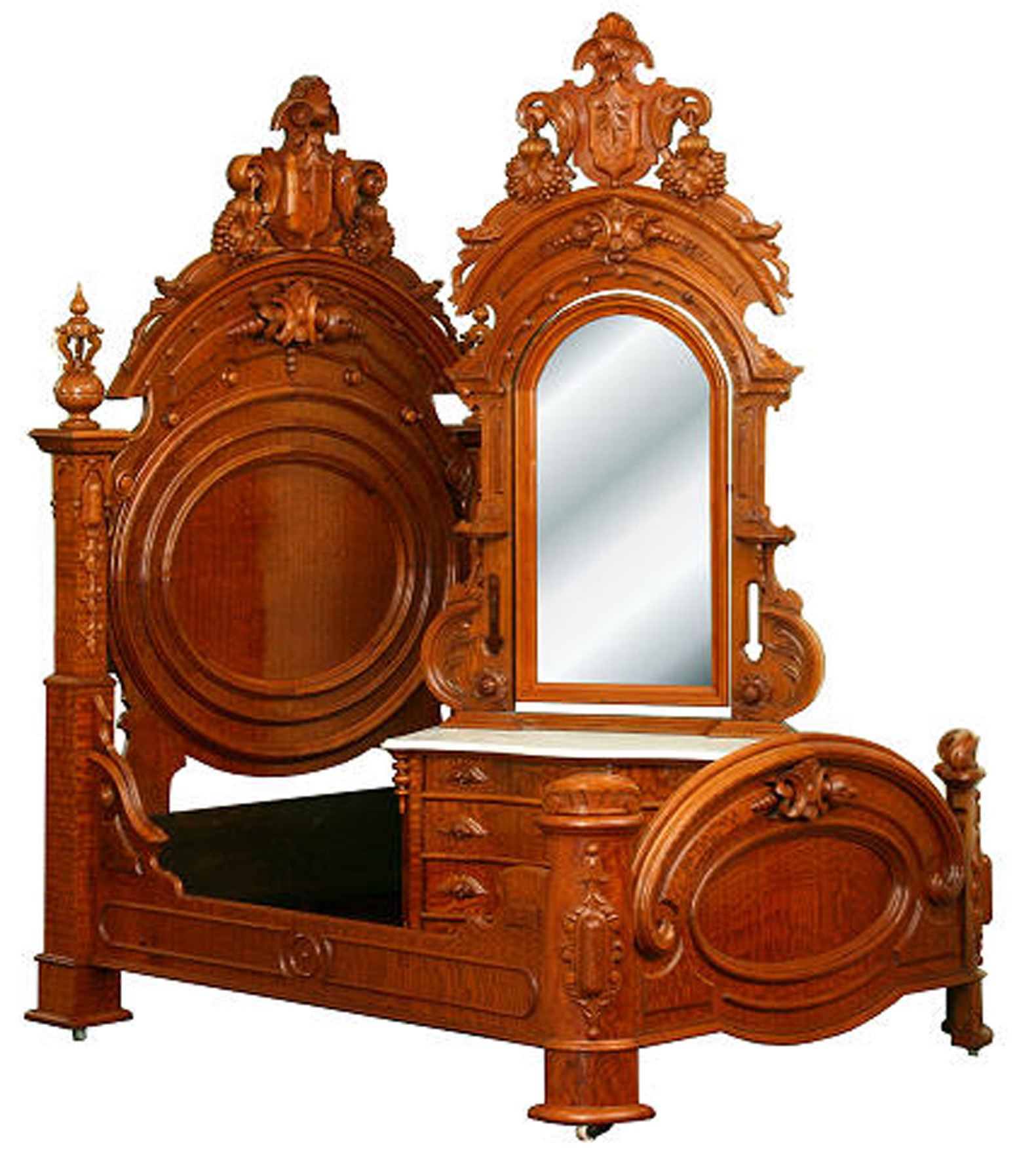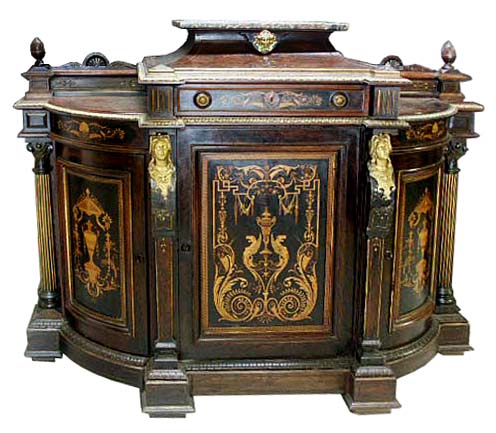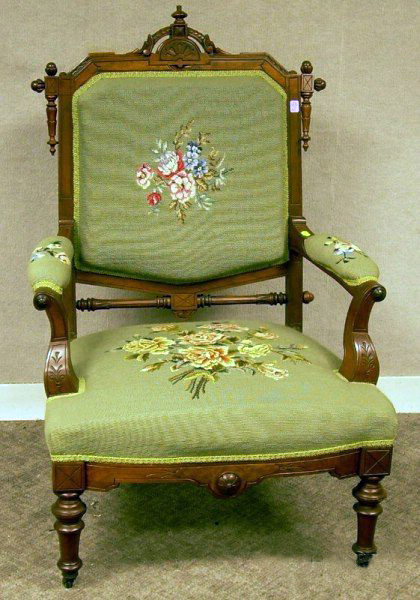
CRYSTAL RIVER, Fla. – When young Victoria became queen of England in 1837 after the death of her uncle, William IV, the furniture world was energized by new possibilities. English furniture styling was stale, suffering from the lingering effects of the Regency of the Prince of Wales (George IV) and the benign neglect of William IV. American furniture was struggling with late Empire and Classicism and looking for the next thing to come along.
The next great thing, as it turned out, was a previously great thing – or two or three. For inspiration, designers, as they usually do, looked to the past as they have so many times before and came up with an entire series of historical revivals that carried furniture making into the 20th century. With the exception of Charles Locke Eastlake’s designs, virtually all furniture produced during America’s greatest period of expansion in the mid- to late 19th century, whether by hand or in the factory, was a revival of one sort or another.
The first in the series of 19th century revivals was Gothic. The Middle Ages was obviously such a fun time that it naturally needed a encore. In fact, Gothic Revival actually had two incarnations in the 19th century, the first time around in 1830s England and 1840s America and then again in the 1880s as an aesthetic offshoot of William Morris and the Arts and Crafts movement. The first revival was more ornamental than substantive. Contemporary neoclassical styles were adorned with Gothic appointments such as the pointed arch, quatrefoils, trefoils and tracery. Gothic elements such as the rose window were reintroduced into architectural designs and subsequently found their way into chair backs and cabinet doors. The late century version was in fact much more of a true revival of Gothic techniques and style than was the earlier version and some of the work done in the 1880s and 1890s can be difficult to distinguish from the period pieces.
The second in the series of revivals was the Rococo, which also showed up in America in the 1840s. The resurrection of the elaborate Rococo stylings of the courts of Louis XIV and Louis XV was clearly more vigorous than the original 18th century versions, with deeper carvings and a larger scale. The innovation apparent in this revival can be seen in the original works of John Henry Belter, Alexander Roux and the Meeks brothers. The technique of lamination, originating in the Black Forest of Germany and perfected by Belter, allowed the lavish decoration and embellishments that would have made the French kings proud. The revival also encouraged the production of furniture “en suite,” that is, matching sets of furniture, in particular, parlor suites or sets, to be used in specific rooms. Rococo Revival was widely produced throughout America for more than 30 years but its elaborate decoration ultimately was its downfall because it could not be produced by machinery efficiently and left behind by the technological revolution of the latter part of the century.
Its successor, the last in the line of revivals, was the Renaissance Revival, an architectural form that easily made the transition from the custom, one of a kind shops in New York and Philadelphia to the factories of the Midwest.
Gigantic bed sets were typical of the Renaissance Revival period. They were made to fit the grand scale of the New York and Pittsburgh hotels that catered to the rich oil and industrial barons of the Gilded Age. (Flomaton Auction image)

Introduced in the early 1850s as a counter balance to the flowery Rococo Revival, Renaissance Revival borrowed elements from just about every furniture period since the 1400s. The impetus for the revival originated in the French court of Napoleon III and initially tried to recreate the furniture of the 1400s and 1500s but the form soon took on a life of its own. But what exactly were they trying to revive? What was so wonderful about the Renaissance that it needed to be repeated and whose renaissance were they thinking about?
There were actually several periods of what could be called a renaissance or cultural reawakening but it is generally acknowledged in the West that what is considered to be THE Renaissance began in Italy in the early 14th century and crept throughout Europe over the next three centuries. In the early 1300s some of the greater cities of Italy came under the control of one family, the Visconti family. Soon other alliances under various single family’s rule took shape and as a result, a great deal of wealth was concentrated in the courts of the ruling families. This extreme wealth allowed the support of the arts and humanism that came to be known as the Renaissance. During the Middle Ages, the primary focus of study was theology – during the Renaissance the focus turned to the study of humankind, both physically and intellectually. The previous model for the study of humanity had been the Greeks and after them the Romans so the 14th century turned back to the first century for inspiration.
Since Italy had been the heart of the Roman Empire, there was a certain kinship with the classical past. Historical evidence of the Roman period was everywhere. The palaces of the ruling Italian families were storehouses of new furniture, influenced by Greek and Roman tradition. In addition to classical architectural elements such as columns and pediments, the new furniture was often covered in carvings depicting ancient mythological and historical themes. But in western and northern Europe, when the Romans left, so did the influence. Those parts of Europe continued under the Gothic influence until late in the Renaissance. Francis I, king of France from 1515 to 1547, brought Italian artisans to France to remodel Fontainebleau and ended up with very Italian-like motifs and furnishings with columns, carved human heads and scrolls. His successor, Henry II, continued the style, refining the scale and modifying the traditional cabinet by placing a smaller cabinet on top, resulting in the precursor of the chest on chest, the chest on stand and the drop-front writing desk.
Henry VIII carried the torch in England, importing his own Italian artisans who blended English tradition with Italian Renaissance and produced English Renaissance furniture leading to the development of the first “draw” table in Elizabethan times. This table opened in the middle to accept additional leaves for expansion of the table.
So why was Napoleon III trying to resurrect a 300-year-old style based on first century architecture? As the nephew of Napoleon I, he, along with all of the Bonaparte family, was exiled from France in 1816. At age 8 he fled to Italy and circulated there and in Germany and Switzerland until his first attempted coup in 1836 and the second in 1840, both failures. He returned to France after the Revolution in 1848, was elected to the Assembly of the Second Republic and then was elected president the same year. He eventually concentrated all power in himself and proclaimed himself emperor in 1852. His interest in the revival of the French and Italian Renaissance was his bid to forever link his name to the classical past.
His revival of the style was greeted warmly in America. As the straight-line alternative to Rococo it was fresh and rich looking without being frivolous. It was a welcome change and a new challenge for the brilliant cabinetmakers of the day like John Jelliff, who worked in Newark, N.J., from 1836 to 1860, and Thomas Brooks who worked in New York, from 1841 to 1876. Even one of the great Rococo masters, Alexander Roux in Manhattan, was a player in the Renaissance market. Coming into the business at the beginning of the era was Gustave Herter, also in Manhattan, who opened his shop in 1851, later to be joined by his brother Christian to form the firm of Herter Brothers, one of the great names in Renaissance cabinetmaking. And Daniel Pabst was making his mark, working in Philadelphia from 1854 until his retirement in 1882. George Hunzinger and the firm of Anthony Kimbel and Joseph Cabus, all of Manhattan, rounded out the top of the list of the masters of the period working in the new style. Hunzinger was known for his eclectic use of twists and curves, as seen in this rocking chair (Fred Taylor)
The furniture that these masters built was an eclectic mix of 14th century Renaissance, Neoclassical and 16th century French derivation and was based essentially on the rectangle form with myriad embellishments. Precious metals and semiprecious stones were used as decoration as was porcelain and bronze. Deep gold lined incising and elegant ebonizing were regular features but the decoration, no matter how elaborate, was always anchored by the requisite architectural elements of the column and the pediment, combined with the overall generally massive scale that spoke of the classic periods.= But as elaborate and painstakingly detailed as these masterpieces appeared to be, they still were based on geometric forms with turned, cutout or incised decorative elements that could be mass-produced on a machine and installed in layers to get the deep, complicated look.
Before 1870 virtually all fine Renaissance Revival furniture was made in the East by these and other cabinetmakers on a one by one, custom-order basis. But the Midwest was the next stop and it was growing in importance. Such high-end cabinetmakers as Mitchell and Rammelsberg opened their shop in Cincinnati in 1846 and continued until Rammelsberg’s death in 1863, but they were the early Midwest exception. Most shops and small factories in the area were producing inexpensive goods for the growing mass market and quality was sometimes an afterthought.
Another exception was William S.Wooton of Indianapolis, manufacturer of the famous patent desk bearing the same name and produced overwhelmingly in the Renaissance Revival tradition. But the continuing advances in the third quarter of the 19th century in furniture making technology and machinery meant that high-end, high-quality production was inevitable in the Midwest and the Centennial Exposition in Philadelphia in 1876 was the catalyst.
A few core companies in the Grand Rapids consortium had made the commitment to the application of the latest in technology by the 1870s, among them Berkey & Gay, Nelson Matter and Phoenix and the impact was palpable in Philadelphia. Renaissance Revival was the style of the Centennial Exposition and Grand Rapids was the star. The overpowering bedroom sets presented by Berkey & Gay and the others cemented the reputation of the Grand Rapids factories as THE manufacturers of bedroom sets or “chamber suites” as they were known.
By the 1880s most of the old-line cabinetmakers in the East had retired or died and for the last two decades of the 19th century, the factories of the Midwest had the middle and upper end of the Renaissance Revival market to themselves.
Toward the end of the period some of the big city cabinetmakers like the Herter Brothers and Alexander Roux veered off on a tangent called Neo Grec, a revival of antique Greek styles. (LiveAuctioneers.com)

The inevitable end came from two different directions, the desire to return to simplicity, the antithesis of Renaissance Revival, which embodied itself in the Arts and Crafts movement of the late 19th and early 20th century and the resurgence of interest in American heritage which presaged the coming, and long-running, Colonial Revival period.
An example of the transition, this chair is beginning to show some of the Eastlake influence in the shallow incised carvings. (LiveAuctioneers.com/Skinner)

Renaissance Revival furniture, while not the most favored by many of today’s collectors because of its size and obvious statement, nevertheless played a pivotal role in American furniture history. While furnishing the houses of the newly wealthy industrial class, it provided the link to the first century that proved instrumental in the development of the country’s industrial base in the 19th century, in preparation for the 20th.
More information about Renaissance Revival furniture and it makers can be found in American Furniture of the 19th Century, 1840-1880, by Eileen and Richard Dubrow, (Schiffer); Grand Rapids, The Story of America’s Furniture City, by Christian Carron, (The Public Museum of Grand Rapids,) Collector’s Encyclopedia of American Furniture, Volume I, by Robert and Harriet Swedberg, (Collector Books) and Marked American Furniture, 1640-1940, by William C. Ketchum Jr., (Crown).
Send comments, questions and pictures to Fred Taylor at P.O. Box 215, Crystal River, FL 34423 or email them to him at info@furnituredetective.com. Visit Fred’s newly redesigned website at www.furnituredetective.com and check out the new downloadable “Common Sense Antiques” columns in .pdf format.
His book How To Be a Furniture Detective is available for $18.95 plus $3 shipping. Send check or money order for $21.95 to Fred Taylor, P.O. Box 215, Crystal River, FL, 34423.
Fred and Gail Taylor’s DVD, Identification of Older & Antique Furniture ($17 + $3 S&H) is also available at the same address. For more information call 800-387-6377 (9 a.m.-4 p.m. Eastern, M-F only), fax 352-563-2916, or info@furnituredetective.com. All items are also available directly from his website.


